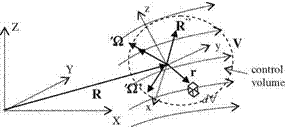Momentum, Equation
The Newton’s second law of motion, based on the conservation of momentum, is applicable only on the systems. According to this law, the forces acting on the system cause a change in their momentum. For a system which is not under the influence of any non-inertial force, let FS be the surface force acting at time t. This surface force changes the N = MV momentum of the system. Here, if we let the momentum be independent of mass, then we find for the relevant property g = N/ M = V. We can now write the balance between the surface forces and the corresponding moment changes at the system which coincides with the control volume at time t.
Vs = O-JJJPV dV+j^PV(V • dA) (2.36)
The forces at the surface of the system can be considered as the integral effect of the stress tensor s over the entire surface of the control volume: FS = fflx. dVA. If we use this on the left hand side of Eq. 2.36 and change the surface integrals to volume integrals with the aid of divergence theorem we obtain
JJJV.(l)dV = 0.JJJp~dJ+JJJV •(p VV)d8 (2.37)
Here, the double arrow and the velocity vector multiplied by itself indicate the tensor quantities. Equation 2.37 can also be expressed in differential form to give the local expression of the momentum equation as
0pV + V • (pV V — ?) = 0 (2.38)
In Eq. 2.38, the stress tensor includes in itself the pressure, velocity gradient and for the turbulent flows the Reynolds stresses and reads like
s = (—p + kV • V)I + іsim ~— <pvv > (2.39)
Here, I is the unit tensor and simV is the symmetric part of the gradient of the velocity vector. According to Stoke’s hypothesis, the coefficient k = -2/3 і, wherein the average viscosity of the species is denoted by p. Equation 2.38 is valid only for the inertial reference frame. If we include the inertial forces, we consider a
control volume in a local non-inertial coordinate system xyz accelerating in a fixed reference frame XYZ. Let the non-inertial coordinate system xyz move with a linear acceleration R" and rotate with angular speed X and the angular acceleration X’ in the fixed coordinate system XYZ as shown in Fig. 2.5.
Let the control volume in Fig. 2.5 be attached to the non-inertial frame of reference xyz. The infinitesimal mass element pdV considered in the control volume in the fixed reference frame XYZ has the acceleration aXYZ. At this stage, the relation between the acceleration a^ in the non-inertial frame and the acceleration aXYZ in the inertial frame in terms of linear acceleration: R", Coriolis force: 2’XxVxyz, centripetal force: Xx(Xxr) and X’xr reads as given in (Shames 1969)
aXYZ = axyz + R’ + 2XxVxyz + Xx(Xxr) + X’xr (2.40)
Here, Vxyz is the velocity vector in xyz and r is the position of the infinitesimal mass pdV in xyz coordinate system. If we write the Newton’s second law of motion in the fixed reference frame for the infinitesimal mass at time t using Eq. 2.40 we obtain
dF = p dV aXYZ = p dV [ axyz + R” + 2XxVxyz + Xx(Xxr) + X’xr] (2.41)
Equation 2.41 can be written for the acceleration in the non-inertial reference frame in terms of the inertial forces
p dV axyz = dF — p dV [R” + 2XxVxyz + Xx(Xxr)+ X’xr] (2.41a)
We know that F = JdF. As the new form of the momentum equation expressed in the non-inertial reference frame xyz we obtain ~S
![]() p dV = o P~ dV+ ^ pV (V • dA)
p dV = o P~ dV+ ^ pV (V • dA)
(2.42)
 |
|
If we consider the surface forces expressed in terms of stress tensor the differential form of the momentum equation becomes
Equation 2.43, can be used, in general, for studying the pitching and heaving – plunging airfoils and finite wings in roll and viscous analysis for drag prediction of fuselages.












 Fig. 2.3 Body fixed x, y, z and the flow fixed x’, y’, z’ coordinate systems
Fig. 2.3 Body fixed x, y, z and the flow fixed x’, y’, z’ coordinate systems Fig. 2.2 a pitch angle and the coordinate systems
Fig. 2.2 a pitch angle and the coordinate systems
